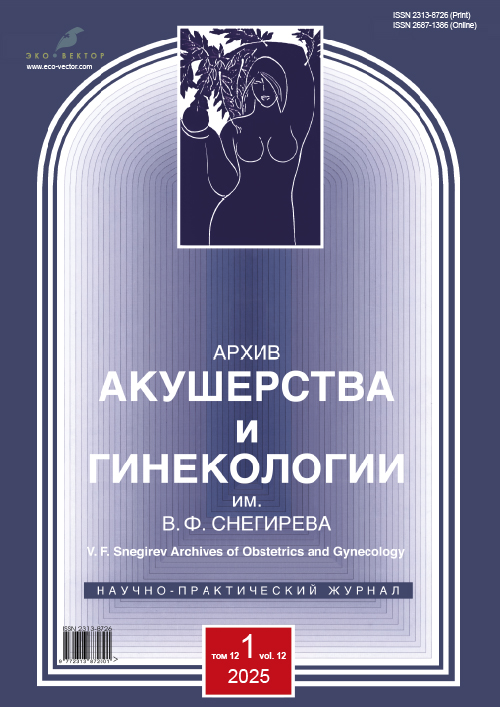Hormonal optimization of ovarian function in women of advanced reproductive age with diminished ovarian reserve
- Authors: Klyukina L.A.1,2, Sosnova E.A.1, Guzov I.I.2
-
Affiliations:
- I.M. Sechenov First Moscow State Medical University
- Medical Center of Immunology and Reproduction
- Issue: Vol 12, No 1 (2025)
- Pages: 66-74
- Section: Original study articles
- Submitted: 29.03.2024
- Accepted: 15.04.2024
- Published: 24.02.2025
- URL: https://archivog.com/2313-8726/article/view/629583
- DOI: https://doi.org/10.17816/aog629583
- ID: 629583
Cite item
Abstract
BACKGROUND: In reproductive medicine, diminished ovarian reserve remains a pressing challenge, particularly in the search for effective strategies to address it. Surgical methods for ovarian activation are actively being investigated, along with ongoing research into hormonal therapies. In this context, researchers worldwide have focused on the potential application of dehydroepiandrosterone (DHEA) to improve ovarian reserve in women of advanced reproductive age who are planning pregnancy.
AIM: To evaluate the effects of DHEA administration on hormonal profile changes and ovarian reserve parameters in women of advanced reproductive age with diminished ovarian reserve, as well as to assess pregnancy and live birth rates in this population.
METHODS: The study included 118 women of advanced reproductive age diagnosed with diminished ovarian reserve. All participants underwent hormonal evaluation on days 2–3 of the menstrual cycle, including measurements of follicle-stimulating hormone (FSH), luteinizing hormone (LH), estradiol, prolactin, anti-Müllerian hormone (AMH), and inhibin B, as well as folliculometry. The participants were then prescribed DHEA at 75 mg/day, with follow-up hormonal evaluation at 3, 6, and 8 months, along with repeated folliculometry. After treatment completion, data were analyzed, and pregnancy rates were evaluated.
RESULTS: DHEA administration at 75 mg/day for 8 months was associated with a significant reduction in gonadotropin levels (FSH: 9.91 [8.60; 10.90], LH: 7.63 [6.40; 8.60]) and an elevation in estradiol levels (90.22 [78.90; 107.60]; p < 0.001). A significant improvement in ovarian reserve parameters was observed, as evidenced by changes in laboratory markers (AMH: 1.08 [0.76; 1.40], inhibin B: 98.38 [88.60; 111.40]; p < 0.001) and ultrasound folliculometry findings, which demonstrated an increase in antral follicle count to 6–7. A significant reduction in the frequency of menstrual cycle irregularities was observed, with the incidence decreasing to 29.2% (26/118). Pregnancy occurred in 31.3% of women (37/118), with spontaneous conception in 62.1% (23/37) and conception achieved via in vitro fertilization in 37.8% (14/37). A live birth rate of 70.2% (26/37) was recorded, whereas 29.7% (11/37) of pregnancies ended in spontaneous miscarriage.
CONCLUSION: DHEA administration at 75 mg/day for 8 months in women of advanced reproductive age with diminished ovarian reserve is associated with improvements in ovarian reserve parameters and an increased likelihood of achieving a desired pregnancy.
Full Text
About the authors
Lidiya A. Klyukina
I.M. Sechenov First Moscow State Medical University; Medical Center of Immunology and Reproduction
Author for correspondence.
Email: lidiaklyukina@mail.ru
ORCID iD: 0000-0001-7602-4584
SPIN-code: 1686-2663
Post-Graduate Student
Russian Federation, 8 Trubetskaya st, bldg 2, Moscow, 119991; MoscowElena A. Sosnova
I.M. Sechenov First Moscow State Medical University
Email: sosnova-elena@inbox.ru
ORCID iD: 0000-0002-1732-6870
SPIN-code: 6313-9959
MD, Dr. Sci. (Medicine), Professor
Russian Federation, 8 Trubetskaya st, bldg 2, Moscow, 119991Igor I. Guzov
Medical Center of Immunology and Reproduction
Email: cir@cironline.ru
ORCID iD: 0000-0002-5628-8758
MD, Cand. Sci. (Medicine)
Russian Federation, MoscowReferences
- Broekmans FJ, Soules MR, Fauser BC. Ovarian aging: mechanisms and clinical consequences. Endocr Rev. 2009;30(5):465–493. doi: 10.1210/er.2009-0006
- Martirosyan YO, Silachev DN, Nazarenko TA, et al. Stem-cell-derived extracellular vesicles: unlocking new possibilities for treating diminished ovarian reserve and premature ovarian insufficiency. Life (Basel). 2023;13(12):2247. doi: 10.3390/life13122247
- Qin Y, Jiao X, Simpson JL, Chen ZJ. Genetics of primary ovarian insufficiency: new developments and opportunities. Hum Reprod Update. 2015;21(6):787–808. doi: 10.1093/humupd/dmv036
- Tucker EJ, Grover SR, Bachelot A, et.al. Premature ovarian insufficiency: new perspectives on genetic cause and phenotypic spectrum. Endocr Rev. 2016;37(6):609–635. doi: 10.1210/er.2016-1047
- Bachelot A, Nicolas C, Bidet M, et al. Long-term outcome of ovarian function in women with intermittent premature ovarian insufficiency. Clin Endocrinol (Oxf). 2017;86(2):223–228. doi: 10.1111/cen.13105
- Baerwald AR, Adams GP, Pierson RA. Ovarian antral folliculogenesis during the human menstrual cycle: a review. Hum Reprod Update. 2012;18(1):73–91. doi: 10.1093/humupd/dmr039
- Smolnikova VYu, Kalinina EA, Krasnoshcheka OE, et al. Possibilities for noninvasive oocyte and embryo evaluation when implementing assisted reproductive technology programs for follicular-fluid growth factor MRNA expression. Akusherstvo i Ginekologiya. 2014;(9):36–43. EDN: STYIUP
- Labrie F, Luu-The V, Lin SX, et al. Role of 17 beta-hydroxysteroid dehydrogenases in sex steroid formation in peripheral intracrine tissues. Trends Endoclinol Metab. 2000;11(10):421–427. doi: 10.1016/s1043-2760(00)00342-8
- Casson P. Dehydroepiandrosterone supplementation augments ovarian stimulation in poor responders: a case series. Human Reproduction. 2000;15(10):2129–2132. doi: 10.1093/humrep/15.10.2129
- Nielsen M, Rasmussen I, Kristensen S, et al. In human granulosa cells from small antral follicles, androgen receptor mRNA and androgen levels in follicular fluid correlate with FSH receptor mRNA. Molecular Human Reproduction. 2010;17(1):63–70. doi: 10.1093/molehr/gaq073
- Ménézo Y, Dale B, Cohen M. DNA damage and repair in human oocytes and embryos: a review. Zygote. 2010;18(04):357–365. doi: 10.1017/s0967199410000286
- Mamas L, Mamas E. Premature ovarian failure and dehydroepiandrosterone. Fertility and Sterility. 2009;91(2):644–646. doi: 10.1016/j.fertnstert.2007.11.055
- Gleicher N, Weghofer A, Barad D. Dehydroepiandrosterone (DHEA) reduces embryo aneuploidy: direct evidence from preimplantation genetic screening (PGS). Reprod Biol Endocrinol. 2010;8:140. doi: 10.1186/1477-7827-8-140
- Zhang M, Niu W, Wang Y, et al. Dehydroepiandrosterone treatment in women with poor ovarian response undergoing IVF or ICSI: a systematic review and meta-analysis. J Assist Reprod Genet 2016;33(8):981–991. doi: 10.1007/s10815-016-0713-5
- Xu L, Hu C, Liu Q, Li Y. The effect of dehydroepiandrosterone (DHEA) supplementation on IVF or ICSI: a meta-analysis of randomized controlled trials. Geburtshilfe Frauenheilkd. 2019;79(7):705–712. doi: 10.1055/a-0882-3791
Supplementary files







